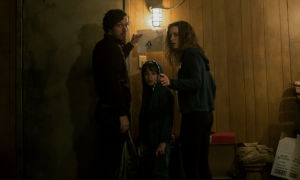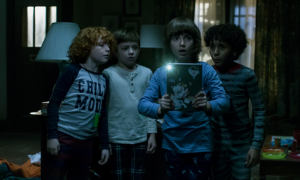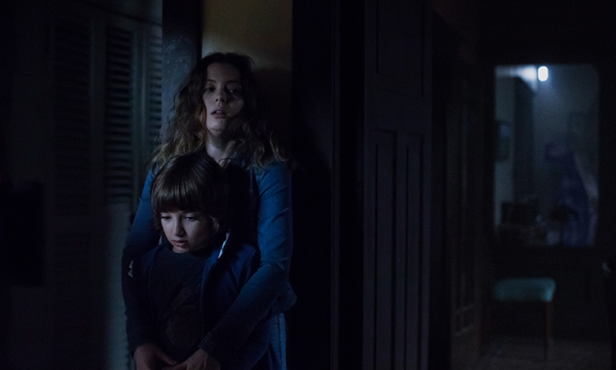Come Play tells the story of Oliver, a solitary autistic boy who comes across a creepy children’s story on his new tablet. He has no idea that by reading the tale of Larry, a lonely monster, also desperate for friends, he is inviting him into his home through that new technology. But what Larry really wants is something far more dangerous…
Written and directed by Jacob Chase, Come Play stars Gillian Jacobs (Fear Street), John Gallagher Jr (10 Cloverfield Lane) and Azhy Robertson (Marriage Story).
We spoke to Chase over Zoom (hoping that Larry wouldn’t join us) about loneliness, autism and creating a monster the whole family can be scared of…

When did you first get the idea for Come Play?
It came from a short I made as an experiment in suspense and trying to prove to people I can make something really scary! The idea itself really blossomed out of what I had around me at the time just because when you make a short, you’re just trying to spend as little money as possible and trying to do something cool.
So I had created this monster costume for a haunted house that I used to run. It used to be me on stilts scaring people in this costume, and I still had the costume in my garage. So I was like, ‘what if I use that and get my friends together and this one actor I know and go to a parking lot and create something with these items we have?’
So that’s honestly where it came from! Of course in developing that I connected the loneliness of a parking lot attendant with the loneliness of this monster that is contacting him. That theme of loneliness and connection is what really blossomed into the ultimate feature film and finding new characters but with the same monster.
What was it about that theme of loneliness and connection that made you want to explore it further in Come Play?
Loneliness, specifically as a child, was something I related to quite a bit. I went through a long phase of very few friends and I definitely longed for some more connection. I think there was a thematic tie between the loneliness that we feel anytime and the loneliness we can also feel when we’re using our devices.
It was important to me that the devices and the technology in the film was not just ‘this is evil’ because technology’s great, I’m on technology all the time. I’m talking right now [over Zoom] because of tech. But it’s something that can both aid in human communication and connection, but also can be quite detrimental to it.
Then in terms of finding the right character at the centre of the story, that really came from my wife [who] works with autistic kids. So for many years, I’ve gotten to know a bunch of amazing autistic children and their families. It’s long been a kind of character I’ve wanted to see in more films frankly, and this seemed like the perfect opportunity because I was already riffing on this idea of communication and tech. Then I was like, ‘what if I marry that with a character who needs the technology to communicate with the world?’ So from there I came up with Oliver, this character who’s autistic and nonverbal, and the story really blossomed from there.

How much research did you undertake into autism?
Tonnes and tonnes! I got to meet so many amazing kids and adults with autism. In this process, my wife was just one of a long string of people I interviewed and met with and shadowed. I would share the script with autistic kids and adults and ask them to tell me what I’m doing wrong, what I’m doing right. I would interview people constantly.
There was this one guy, Sam Rubin, who’s got autism and he was nonverbal when he was Oliver’s age actually. Now he’s incredibly eloquent and he would read every draft of the script for me and give me all sorts of feedback and notes. I tried to just surround myself constantly with as much as I could so that I could create the most authentic portrayal.
Whenever you’re writing a character that’s not like yourself, I think we have an obligation to… since we don’t have the lived experience, create the learning experience for ourselves as best we can. Then also surround the production team – we hired this amazing VFX house, Exceptional Minds, which only hires autistic adults to do the effects work. So we had them do a bunch of VFX on the film, so it was just trying to be as authentic as we could and try to be as inclusive as we could in making the movie.
Why did you decide to focus the story on the monsters lurking behind the latest technology?
I think the best horror movies have always been on the cusp of technology and making you afraid of what’s new. Poltergeist was all about the TV, The Ring remake was all about the VHS tape in America… so I think, for me, we are surrounded by our screens constantly and so what better things to make us afraid of, in a movie, than something that we are all going to use as soon as we stop watching the movie?! Or, you know, even maybe watch the movie on the thing!
So, the idea of using what’s around us really intrigued me and taking something that seems otherwise innocuous and making it sort of a window to terror. But then what I would say is that what I tried to do is use that as our sort of door to this horror, but then try to erase it as quickly as possible or leave it behind, and make sure that the real terror is not the screen, it’s what’s behind the screen. It is the monster, Larry, that’s the primal fear we’re afraid of.

That monster lurking in the technology is Larry – how did you begin to create him? And why give him such a common name?
For me, so many of our favourite horror icons have seemingly innocuous names; Jason, Freddy, Michael, you know, because it’s not about the name, it’s about what they’re doing and who they are underneath. So I like the idea of this monster who on its face was scary looking but as you got to know them more as a character there was something empathetic about them, you understood their plight a little bit.
You hopefully understand what it feels like to be lonely or need a friend, which is ultimately what Larry wants, and goes about it in all the wrong ways of course! I wanted someone we could relate to as a monster, those are all my favourite villains, like Frankenstein’s monster.
In terms of creating the monster himself, I wanted to do it practically. That was really important to me to carry over what I did from the short into the feature. Also, I think audiences just react to practical monsters in a more visceral way, and the actors on set, especially young actors, like having this big monster to be freaked out by. [It] gives you just the most genuine reactions. So the Jim Henson Creature Shop made us this nine-foot-tall puppet, it’s amazing! It’s operated by four puppeteers, and it was great because you could be on set and actually have the monster interacting with everyone and you kind of had to squint your eyes and not look at the four blue men in suits operating him [haha] but it was truly terrifying. They did such an amazing job.
My direction to them was to create something that of course was terrifying but it moved in a way that felt as sad and lonely as their internal psyche was. That continued on to even the sound design at the end, just creating a sound for the character that felt pain as they walked uncomfortably and you could feel that empathy for them even as they were scaring you.
Come Play focuses on some important themes such as loneliness and autism, what makes horror a good platform to discuss themes like this?
Horror films are a great avenue to get to play with some really important, timeless themes or very new themes that we haven’t played with before. I think it works because a lot of people love horror films! I love horror films, there’s a big audience. What’s great about it is you can get such a wide audience to experience a horror movie, and then you can have this thematic stuff that otherwise may have felt like homework or a movie you wouldn’t want to go see. But when it’s surrounded by this really fun shell of a film, this horror excitement of scares and characters who are fighting for their lives and stuff, it just makes you care about the characters more. It feels all the more real when it’s about something that we can all relate to or something that we can see our friends relating to. So I think it’s about creating dramas within a horror framework, it’s like this backdoor way to create a drama by making a horror movie.
But also the horror is the most fun part about it because you’re getting to really play with the audience. You’re in conversation with the audience when you’re making a horror movie. So in the same way, thematically you want to be in conversation with the audience as well.
What kind of scares can audiences expect from Come Play?
In Come Play we get to have quite a wide variety of types of scares. There’s general suspense throughout and there’s definitely a children-in-peril kind of feeling. Some of my favourite movies like ET and Poltergeist were not afraid to scare kids, but it’s also a movie that I think is appropriate for a family.
The movie’s not super violent, even though scary things happen to people. I wasn’t wanting to make something that ended up being R-rated or was super bloody, but rather something that both adults and their kids could connect to and connect to this very special family at the centre.
So there are scares of all kinds. There’s supernatural stuff. There are jump-scares sure, but hopefully, at the end of the day, people feel the compassion I was trying to put into it in the heart of the film…
Come Play will be released in the UK on digital download from 13 September 2021.

